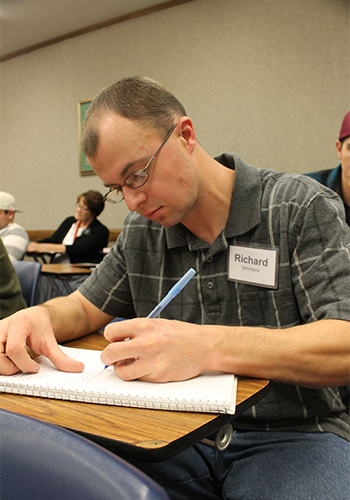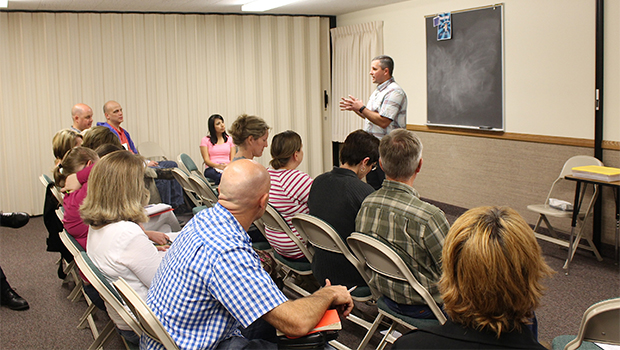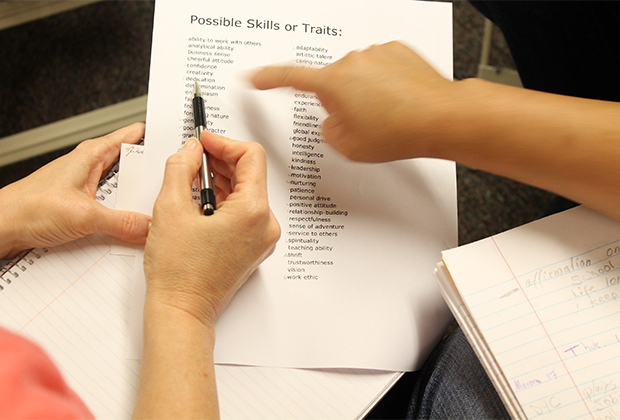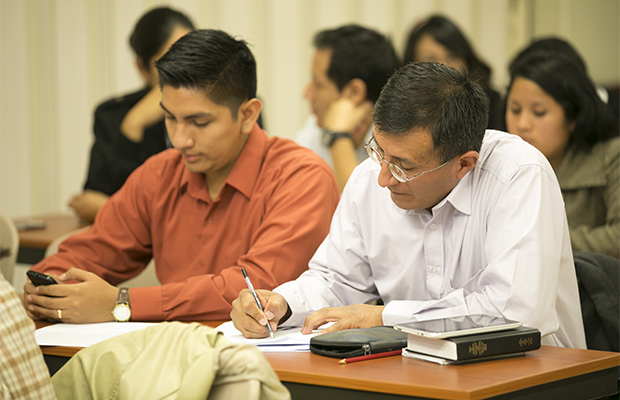BYU–Idaho’s Pathway Program Blesses Students Worldwide
Contributed By Marianne Holman Prescott, Church News staff writer
.jpg)
Pathway students in Rome, Italy, pose for a photo during one of their Thursday night meetings.
Article Highlights
- BYU–Idaho’s Pathway program has turned into a worldwide program serving more than 40,000 students in nearly 40 countries.
- Students take three required courses—all done online—and meet with a cohort group once a week on Thursday night wherever institute is held in the area.
- More than 13,000 students have received a Pathway certificate, and 8,673 students are now enrolled in the BYU–Idaho online degree program.
“Pathway not only helps teach students how to learn and prepare to provide for their families, but it also helps deepen discipleship.” —Clark G. Gilbert, Brigham Young University–Idaho president
Related Links
On July 23, Carolina Galvis put on her cap and gown and gathered with other graduates in the BYU–Idaho Center for commencement exercises. Gaining an education was one of her lifelong goals, and she had finally made it to graduation.
To many in the crowd on campus that day, the buildings and people were a common sight. For graduate Sister Galvis, the sounds and sights were all new. It was her first time on the Brigham Young University–Idaho campus. And it was the day she received her diploma for her degree in business management and entrepreneurship.
“I am the first generation in my family getting an education,” Sister Galvis, originally from Venezuela and now living in the Charles River Ward, Cambridge Massachusetts Stake, said. Although she had tried many times over the past decade to attend college, it wasn’t until she heard about the Pathway program that she was able to make her dream a reality.
“I love the Pathway program,” she said. “It’s a beautiful program and experience. It was definitely an answer to prayer.”
After completing BYU–Idaho’s Pathway program she was able to complete her requirements for a bachelor’s degree online through BYU–Idaho while still living in the Boston, Massachusetts, area. Her “path” of education had been a little rocky at times, but through her persistence she finished her degree five years after she started.
Her next goal—BYU law school.
Sister Galvis is one of the 71 students who began their education through the Pathway program and have now earned a bachelor’s degree through online learning at BYU–Idaho.
“This fall marks our sixth year,” J. D. Griffith, Pathway managing director, said. “It has been amazing to watch.”

Richard Simmons takes notes during the presentation of the Thursday night class on October 15. Photo by Rodney Boam.

Pathway in partnership with BYU–Idaho. Photo by Aaron Thorup.
With 387 sites around the world, students of all ages and backgrounds are getting started on a “path” that leads to education. What started out as three pilot classrooms around the U.S. in 2009 has turned into a worldwide program serving more than 40,000 students in nearly 40 countries and 42 U.S. states.
“The Pathway program started domestically and continues to grow all across the United States,“ said Clark G. Gilbert, Brigham Young University–Idaho president. “But the program is also seeing tremendous growth internationally. This fall, over half of nearly 400 Pathway sites will be international. We have launch programs in Asia, Africa, Latin America, and Europe. In Mexico alone there are over 70 Pathway sites. BYU–Idaho also continues to develop academic programs that fit the needs of an increasingly international Church.”
More than 13,000 students have received a Pathway certificate, and 8,673 students are now enrolled in the BYU–Idaho online degree program.
“We’ve added an entire university to this university,” Andy Cargal, who has been with the Pathway program since it began in 2009, said. “It’s a very humbling situation that there is a need for this around the world. … It started with the concept ‘How do we take education to students who can’t come to this campus?’”
Although the program was designed for traditional college-age students who for some reason didn’t enroll or stopped attending college for various reasons, students of all ages are responding by enrolling in the Pathway program. Half of the Pathway student body is age 31 or older.
Students take three required courses—all done online—and meet with a cohort group once a week on Thursday night wherever institute is held in the area. The required three courses—life skills, math and personal finance, and basic writing, as well as religion courses—make up a year of studies.
“Students are doing a lot of it on their own,” Brother Cargal said. “But the gathering aspect once a week is important. … As students meet together, more learning can happen with both the spiritual and educational benefits.”
After students have taken the required courses and met the specific requirements for the courses, they are able to transfer to another institution to finish their degree. Although transferring to BYU–Idaho online is an option, it isn’t the only option, Brother Cargal said.
“They could choose to get an online degree, or they can transfer to a local university,” Brother Cargal said. “We just want them to get an education. We are trying to provide a pathway for them.”
Pathway missionaries lead the Thursday night class, which incorporates class participation and some gospel elements. Because of the growth and availability of the program worldwide, missionaries are crucial to the program’s success. In 2009, a total of six service missionaries were helping with the program. This year 1,758 missionaries are serving in various locations scattered around the world.
“The Lord has blessed us with amazing couples and missionaries,” Brother Griffith said. “The Pathway missionaries are essential to the program; they are our eyes and ears, and we rely heavily on them. What a blessing [they] are to us.”
While some sites have as many as 500 students comprising many classes, other sites have only a handful of students during their weekly meeting.
Elder Leo Memmott and Sister Florence Memmott of Bountiful, Utah, are serving as Pathway missionaries for students living in the Italy Rome Mission.
“It’s our testimony that it’s the Lord’s program, that it is His way to give His children the opportunity to better their lives,” Elder Memmott said. “And they are taking it.”
Elder Memmott said he has seen how students’ lives have changed as they have made sacrifices—such as traveling 8.5 hours each week—to further their education.
“The Lord has a path for each of us individually,” Sister Memmott said. “It is our responsibility to find that path that the Lord has planned for us. The Pathway program is set up so that they can find their path. It’s a pathway that will bless many eternally. It’s a path that brings blessings for all eternity.”
Although the Pathway program does not require an ecclesiastical endorsement like Church-owned schools, it still integrates gospel learning as part of a student’s education.
“The Pathway program provides clear educational and life opportunities for students,” President Gilbert said. “In addition to developing strong academic options, the greatest benefit is perhaps an ecclesiastical one—Pathway students grow spiritually and become more committed to the gospel of Jesus Christ. Pathway not only helps teach students how to learn and prepare to provide for their families, but it also helps deepen discipleship.”
For many Pathway students, the impact of the program goes beyond academic achievement. Integrating the gospel in their education helps them not only get on or return to the path of education but also ignites or strengthens a desire to deepen their conversion to the gospel of Jesus Christ.
“We’ve got a lot of stories of conversion,” Brother Griffith said. “Those are the stories that touch my life the most. … It’s the process—it’s a change of heart and a change of mind. As they are associating themselves with others and have people helping them along the way, those changes occur.”
Students—young and old—who have been away from the Church for years are returning to activity. Mothers and fathers are renewing their commitment to their families and to the gospel, and returned missionaries are finding a place to land post-mission that enables them to progress in their own life while continuing to serve others.
“In some cases, Pathway offers returned missionaries an opportunity to continue the progress they made in the mission field. They can return and immediately have a path toward education in an environment where they serve and grow spiritually with others,” President Gilbert said. “In other cases, Pathway offers not only a restart on academic opportunities but also a chance to reconnect with others in the Church. Local Church leaders and students share many stories of how Pathway allows people to come back to the Church and gather again with the Saints in ways that strengthen individuals and future families.”
For more information about the Pathway program, visit pathway.ChurchofJesusChrist.org.

From left: Suzuki Gutiérrez de Diaz holding Omner Helaman Diaz Gutierrez, Omar Diaz Piñera, President Clark G. Gilbert, Reynaldo Diaz (Omar’s father), and Benjamin Diaz Piñera (Omar’s brother). Omar was a Pathway student who is now enrolled in the BYU Marriott School of Business. Photo by Marianne Holman Prescott.

Pathway students in Rome, Italy. Photo courtesy BYU–Idaho.

Pathway student Ryan McBride leads a discussion during class on Thursday, October 15, in Logan, Utah. Photo by Rodney Boam.

Pathway students work on a ”getting to know yourself“ activity during class on Thursday, October 15, in Logan, Utah. Photo by Rodney Boam.

A Pathway missionary works with two students in one of the program's sites in Italy. Photo courtesy Sister Florence Memmott.
.jpg)
Ken Clark, Albert Purser, and Joy Goodman work together during a Pathway class held on Thursday, October 15, in Logan, Utah. Photo by Rodney Boam.

Pathway students meeting in Lima, Peru, work together during a class held in the summer of 2015. Photo by Gabriel Paredes.

Pathway students meeting in Lima, Peru, work together during a class held in the summer of 2015. Photo by Gabriel Paredes.

Pathway students in Rome, Italy, meet together for a class. Photo courtesy BYU–Idaho.
